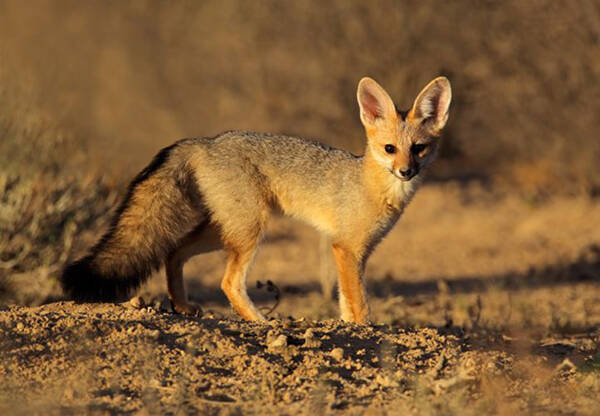Vulpes chama,
IUCN
LCBasic Information
Scientific classification
- name:Vulpes chama,
- Scientific Name:Vulpes chama,Cape Fox,silverback fox, cape fox, cape fox
- Outline:Carnivora
- Family:Schizopoda Canidae Vulpes
Vital signs
- length:45-61cm
- Weight:3.6-5kg
- lifetime:About 10 years
Feature
They mainly feed on insects and are very intelligent.
Distribution and Habitat
Origin: Angola, Botswana, Namibia, South Africa.
Cape foxes live in the deserts of sub-Saharan Africa. They live mainly in open areas, commonly in grasslands and coastal semi-desert shrubs. There are often seasonal "ponds" formed around shallow water in the grasslands, which are filled with water during the rainy season and provide a living environment for this species. They are also scattered in areas with dense vegetation or slightly dense trees. They also live on rocks, low ridges and flat gravel plains.
Appearance
The Cape fox is a small fox with a light body and agile movements. The head and body are 45-61 cm long and the shoulder height is 28-33 cm; the weight is 3.6-5 kg. There is a pair of particularly large reddish-brown ears, which can reach 13 cm in length, and the enhanced hearing system allows the species to easily detect potential predators and prey. There is also a bushy tail about 30-40 cm long, which is almost half the length of the head and body. The teeth are small. The fur on the head and forelimbs is reddish. The body hair is yellow-brown, black or silver-gray, the ears, legs and part of the face are black, there are white areas on the cheeks, the sides and underparts of the body are light yellow, and the abdomen is whitish. There are black patches on the hind limbs. The tip of the tail is black. Females are about 5% smaller than males.
Details
Cape fox (scientific name: Vulpes chama) is also known as Cape Fox, and has no subspecies.

Cape foxes are mainly nocturnal, although cubs play outside the cave during the day. The species forages alone or in pairs. Cape foxes are not very territorial, with overlapping ranges that vary from 1.0-4.6 square kilometers. They sometimes nest in communities, and their social organization is not well known.
Cape foxes are omnivores, feeding on small mammals, reptiles, insects, fruit, and carrion. They also poach livestock, which often puts them in a difficult position to be hunted by humans. The distance between the canine teeth varies, and people have measured bite marks between Cape foxes (15 mm) and black-backed jackals to determine which species is responsible for killing livestock.
Cape foxes live in the same areas as coyotes, black-backed jackals, and bat-eared foxes, so competition may limit their populations. However, there is enough separation in activity time, space, and diet to allow their coexistence.
The domesticated Cape fox is considerate and often curls up in a ball, sleeping on the same bed with people, inseparable. The Cape fox's beauty and lover's characteristics may have become its excuse for being "capable of changing and confusing people". Cape foxes are extremely alert. Observe the Cape fox hunting a hare. It lowers its body to the ground, hides its head between its front paws, its ears slowly draw circles in the air, and its eyes do not blink, like a spotlight, following the rapid movement of the hare.
The intelligence of the Cape fox is sometimes incredible. A breeder said that he brought a well-fed Cape fox into the office and gave it its favorite meat bun. It hesitated at first, and finally pulled a newspaper to cover it before it felt relieved. It is said that well-trained Cape foxes even understand music, and Cape foxes are so smart that they are comparable to primates.
Cape foxes are monogamous. Females and males appear in pairs in the spring. Fox pups are born in early summer. In the southern hemisphere, pairs form during the winter months of July and August. The gestation period is 51-52 days, and each litter contains 3-5 pups. There is only one litter per year, but multiple litters have been observed in some breeding areas. Pups are usually born in late spring to early summer, from September to November, but breeding has also occurred in late December. The male fox provides food for the female during the first and second weeks after the pups are born, and both parents care for the pups. It is not clear how long the male stays with the family. The pups begin to forage at 4 months and become independent after 5 months. Sexual maturity is reached at 9 months.
More than 2,500 kiwi foxes are killed each year, about 16% of the total population. This has caused damage to the species. The protected kiwi fox population lives in the Soetdoring Nature Reserve with an area of 1.3 square kilometers, and the Willem Pretorius Game Reserve with an area of 0.65 square kilometers (southern) and 0.12 square kilometers (northern).
Listed in the 2014 Red List of Threatened Species of the World Conservation Union (IUCN) ver 3.1 - Least Concern (LC).
Protect wildlife and eliminate bushmeat.
Maintaining ecological balance is everyone's responsibility!








